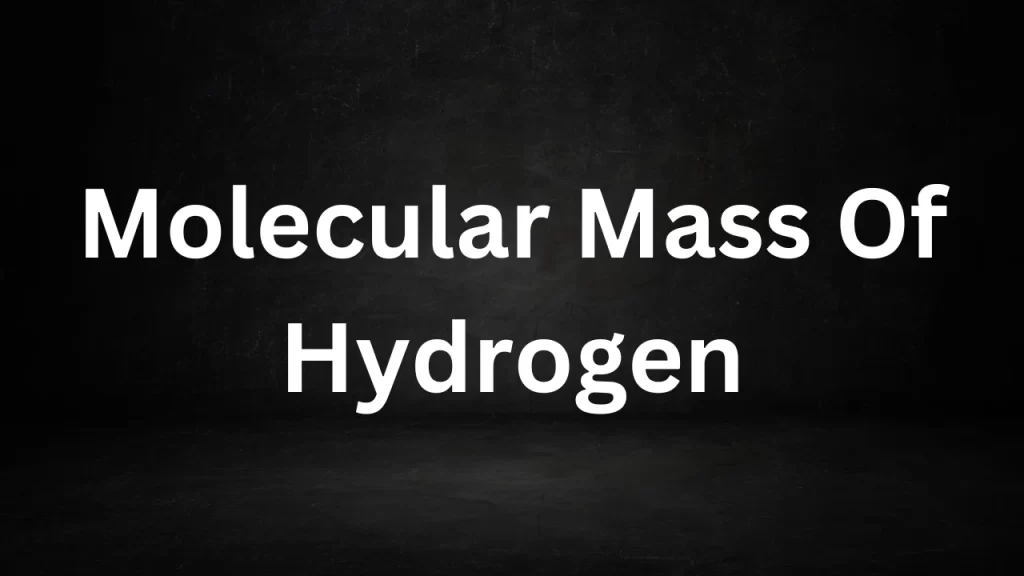Tag: Molecular Mass Of Hydrogen
Molecular Weight Of H2
Molecular Weight Of H2: Molecular weight, also known as molar mass, is a fundamental concept in chemistry that plays a crucial role in understanding the properties and behavior of substances.
In this article, we explore the molecular weight of one of the simplest molecules in the universe – H2, or molecular hydrogen. While its molecular weight is exceptionally light, its significance in the cosmos and in various scientific applications is profound.

Molecular Weight Of H2
Understanding Molecular Weight
Before delving into the molecular weight of H2, it’s essential to grasp the concept of molecular weight itself. Molecular weight represents the mass of a molecule, expressed in atomic mass units (amu) or unified atomic mass units (u). It is ascertained by summing the atomic masses of all the atoms present within a molecule. For molecular hydrogen (H2), this calculation involves adding the atomic mass of two hydrogen atoms (H).
The Composition of H2
Molecular hydrogen (H2) consists of a pair of hydrogen atoms (H). The atomic mass of hydrogen is approximately 1.008 amu. When we calculate the molecular weight of H2, we sum the atomic masses of its constituent atoms:
Molecular weight of H2 = Atomic mass of H + Atomic mass of H
The Molecular weight of H2 = 1.008 amu + 1.008 amu
Molecular weight of H2 ≈ 2.016 amu
The molecular weight of H2 is approximately 2.016 atomic mass units (amu).
Significance of H2
Molecular hydrogen (H2) may be one of the simplest molecules, but its significance extends far beyond its simplicity:
- Abundance in the Universe: Molecular hydrogen is the most abundant molecule in the universe. It plays a crucial role in the formation of stars and galaxies and is a primary component of interstellar clouds.
- Energy Source: In various scientific applications and industries, H2 serves as an energy carrier and a potential clean fuel source. Hydrogen fuel cells, for instance, use H2 as a clean and efficient source of electricity.
- Chemical Reactions: H2 is involved in numerous chemical reactions and processes, such as hydrogenation reactions in the chemical industry and the Haber-Bosch process for ammonia production in agriculture.
- Research Tool: In scientific investigations, H2 is employed in numerous experiments, including research involving nuclear magnetic resonance (NMR) spectroscopy and crystallography.
Applications of Molecular Weight
Understanding the mole weight of substances like H2 is crucial in various scientific and industrial contexts:
- Chemical Analysis: Molecular weight is used to identify and quantify substances in chemical analysis techniques like mass spectrometry.
- Dosage Calculations: In pharmaceuticals and medicine, molecular weight helps calculate the dosage of medications and ensures accurate drug formulations.
- Stoichiometry: In chemical reactions, the concept of molecular weight is essential for stoichiometric calculations, determining reactant and product quantities.
- Polymer Science: Molecular weight is central in polymer science, where it defines the size and properties of polymers.
Conclusion
The mole weight of H2, approximately 2.016 atomic mass units (amu), may be incredibly light, but its significance in the universe, scientific research, and various applications is substantial. Understanding molecular weight is not only fundamental in chemistry but also plays a pivotal role in advancing technology, energy solutions, and our understanding of the cosmos. It exemplifies how even the simplest of molecules can have a profound impact on science and the world around us.
Read More
- Molar Mass Of Methane
- Molecular Mass Of Sodium Hydroxide
- Molar Mass Of Ethyl Alcohol
- Molecular Mass Of Calcium Carbonate
- Molar Mass Of Carbon Dioxide
Frequently Asked Questions (FAQs) On Molecular Weight Of H2
1. What is the molecular weight of H2?
The mole weight of H2, or molecular hydrogen, is approximately 2.016 atomic mass units (amu) or unified atomic mass units (u). This value is obtained by adding together the atomic weights of its two hydrogen atoms (H).
2. Why is the molecular weight of H2 important?
The mole weight of H2 is important because it provides insights into the mass of a hydrogen molecule, which is the simplest molecule in the universe. It is crucial for various scientific and industrial applications, including energy research, chemistry, and dosing calculations in pharmaceuticals.
3. How do you calculate the molecular weight of H2?
The mole weight of H2 is determined by summing the atomic masses of its two hydrogen atoms. The atomic mass of hydrogen is approximately 1.008 amu (or u), so for H2, you sum 1.008 amu + 1.008 amu, resulting in a mole weight of approximately 2.016 amu.
4. What is the significance of molecular hydrogen (H2) in the universe?
Molecular hydrogen (H2) is the most abundant molecule in the universe. It plays a crucial role in the formation of stars and galaxies, and it is a primary component of interstellar clouds. Understanding H2 is essential for astrophysics and cosmology.
5. What are the applications of molecular hydrogen (H2) on Earth?
H2 serves as an energy carrier and a promising clean fuel source in diverse scientific applications and industries. It finds application in hydrogen fuel cells for efficient and environmentally friendly electricity generation. Additionally, it plays a role in various chemical reactions, including hydrogenation processes and ammonia production.
Molecular Mass Of Hydrogen
Molecular Mass Of Hydrogen: H2, the lightest and most abundant element in the universe, plays a fundamental role in chemistry, physics, and astrophysics.
One key aspect of H2 is its molecular mass, a concept that underpins our understanding of chemical reactions, gas properties, and the composition of matter. In this article, we will explore the molecular mass of H2 and its significance.

Molecular Mass Of Hydrogen
The Basics of Molecular Mass
Molecular mass, also known as molecular weight or molar mass, is a crucial concept in chemistry. It represents the mass of a molecule and is typically expressed in atomic mass units (u) or unified atomic mass units (AMU). Molecular mass is calculated by summing the atomic masses of all the atoms in a molecule.
Hydrogen: The Simplest Element
H2 is the simplest and lightest element in the periodic table. It has an atomic number of 1, indicating that it has one proton in its nucleus. The most common and stable form of hydrogen is the diatomic molecule H2, where two hydrogen atoms are chemically bonded together.
Atomic Mass of Hydrogen
The atomic mass of H2 is approximately 1.00784 atomic mass units (u). This value accounts for the most common isotope of hydrogen, known as protium (¹H), which consists of one proton and one electron.
Calculating the Molecular Mass of Hydrogen (H2)
To calculate the molecular mass of hydrogen (H2), we simply add the atomic masses of the two hydrogen atoms in the molecule:
Molecular Mass of Hydrogen (H2) = (Atomic Mass of H2) x 2 Molecular Mass of Hydrogen (H2) ≈ (1.00784 u) x 2 ≈ 2.01588 u
Rounded to four decimal places, the molecular mass of hydrogen (H2) is approximately 2.0159 atomic mass units (u).
Significance of Hydrogen’s Molecular Mass
Understanding the molecular mass of H2 is of paramount importance in various scientific and practical contexts:
- Chemical Reactions: In chemical reactions involving hydrogen, its molecular mass is crucial for stoichiometry calculations. It helps determine the amount of H2 required or produced in a reaction.
- Gas Properties: H2 is used as a fuel and in gas mixtures for various applications. Its molecular mass influences its behavior as a gas, including density, solubility, and combustion properties.
- Energy Storage: Hydrogen is considered a clean and efficient energy carrier. Its molecular mass affects the energy density of hydrogen fuels and their storage and transportation.
- Astrophysics: Understanding the molecular mass of H2 is vital in astrophysics, where H2 is the primary element in stars and the universe’s most abundant element.
- H2 Bonding: H2 bonds with other elements and molecules, and its molecular mass influences the strength and characteristics of these bonds.
- Fuel Cells: In H2 fuel cells, which are used for power generation and transportation, the molecular mass of H2 plays a role in efficiency calculations.
Conclusion
The molecular mass of hydrogen (H2), approximately 2.0159 atomic mass units (u), is a fundamental property of this elemental gas. Its significance extends from the microscopic world of chemical reactions to the vast reaches of the universe in astrophysics. Whether it’s powering vehicles, fueling stars, or driving chemical reactions in the laboratory, the molecular mass of H2 is a foundational concept that enriches our understanding of the physical and chemical properties of matter.
Read More
- Molecular Mass Of Nacl
- Molecular Mass Of Naoh
- Molecular Mass Of Nitrogen
- Molecular Weight Of Glucose
- Molecular Mass Of Oxygen
Frequently Asked Question (FAQs) Molecular Mass Of H2
1. What is the molecular mass of hydrogen (H2)?
The molecular mass of hydrogen (H2) is approximately 2.0159 atomic mass units (u). This value is calculated by adding the atomic masses of the two H2 atoms in the molecule.
2. Why is the molecular mass of H2 significant?
The molecular mass of H2 is essential in various scientific fields, including chemistry, physics, and astrophysics. It influences chemical reactions, gas properties, energy storage, and our understanding of the universe.
3. How is the molecular mass of H2 calculated?
The molecular mass of hydrogen (H2) is calculated by multiplying the atomic mass of H2 by 2, as there are two H2 atoms in the H2 molecule. The atomic mass of H2 is approximately 1.00784 atomic mass units (u).
4. What are the implications of H2 molecular mass in chemical reactions?
Hydrogen’s molecular mass is crucial in stoichiometry calculations, helping determine the quantities of H2 involved in chemical reactions. It plays a fundamental role in chemical synthesis and analysis.
5. How does H2 molecular mass affect its behavior as a gas?
Hydrogen’s molecular mass influences its gas properties, including density, solubility, and combustion characteristics. It is used as a fuel in various applications due to its low molecular mass and high energy content.